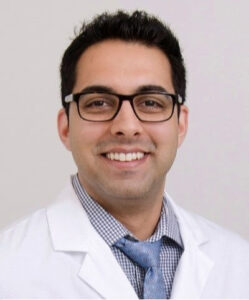
The emergence of the novel coronavirus (COVID-19) forced just about every individual, and every organization, to discover new ways to achieve their goals and reach positive outcomes.
Shyamal Majithia, MD ’14, a family medicine physician at Western New York Immediate Care in and around Buffalo, NY, has been accustomed to providing in-person urgent and emergent care for patients of all ages and backgrounds. However, in light of recent events, much of that care has shifted online, including Teladoc Health, for which Dr. Majithia serves as an independent contractor.
He sat down with St. George’s University to describe his experience with administering telemedicine during a crucial time in healthcare.
St. George’s University: What has your experience been like working for Teladoc Health?
Shyamal Majithia: During the current pandemic, the need for access to medical advice and care has grown rapidly. Working with Teladoc was relatively easy to get used to from the obtaining of emergency medical records and ‘seeing patients’ aspect. We provide care via video and/or over the phone. For minor complaints, patients can be seen quickly and efficiently allowing them to get a genuine medical opinion from a licensed professional rather than being left to find their own answers during the pandemic.
SGU: What are some of the trends you are seeing in telemedicine?
SM: I believe telemedicine will soon become a staple of most healthcare practices. It provides a much wider access to care. Minor injuries are treated with relative ease. Patients now upload their photos or are being evaluated by a physician over video chat. These trends are particularly used as viable tools in specialties such as dermatology and psychiatry.
SGU: How has the telehealth traffic been affected by the COVID-19 pandemic?
SM: There has definitely been an increase in the use of telemedicine in recent months. I remember logging onto Teladoc and seeing the patient queue with a wait time of over three hours at times of patients waiting for callbacks. It was understandable as everyone was trying to shelter in place and help flatten the curve. Now that the country has been reopening, people have continued to seek telemedicine options because they’ve had their issues resolved, resulting in a positive experience.
“I remember logging onto Teladoc and seeing the patient queue with a wait time of over three hours.”
SGU: How have hospitals/medical practitioners had to adjust to practicing telemedicine?
SM: There was a learning curve when it came to adjusting to practicing telemedicine. Medicine is such a personal experience, usually practiced face to face with a physician. It was hard to imagine not doing a full physical exam, or having immediate access to a set of vitals. My colleagues and I have definitely had to adjust the way we navigate health problems over the phone. This is where new features such as being able to see uploaded photos or logging on to a video chat can be a big help in aiding in diagnosis.
In preparation for the upcoming possible second wave coupled with flu season, we have also begun integrating telemedicine into our clinics to allow our patients a safe way to seek care.
SGU: Can you share a time when practicing telemedicine was particularly helpful to you? Also, where do you see it going in the future?
SM: With the shelter in place order, volumes dropped in emergency rooms and urgent care practices. Telemedicine allowed me another way to fill my schedule and feel like I was contributing during the pandemic. It allowed me to set my own work hours, and see patients after my urgent care job as well. I see telemedicine here to stay. With today’s access to technology such as phones, tablets, and computers, patients have almost 24-hour access to care from the comfort and safety of wherever they are.
– Ray-Donna Peters
[av_button_big label=’On the Blog: 5 Benefits of Telehealth in the Zoom Era’ description_pos=’below’ link=’manually,https://www.sgu.edu/blog/medical/5-benefits-of-telehealth-in-the-zoom-era/’ link_target=’_blank’ icon_select=’no’ icon=’ue800′ font=’entypo-fontello’ custom_font=’#ffffff’ color=’theme-color’ custom_bg=’#444444′ color_hover=’theme-color’ custom_bg_hover=’#444444′ av_uid=’av-2gzu9j’ custom_class=” admin_preview_bg=”][/av_button_big]
